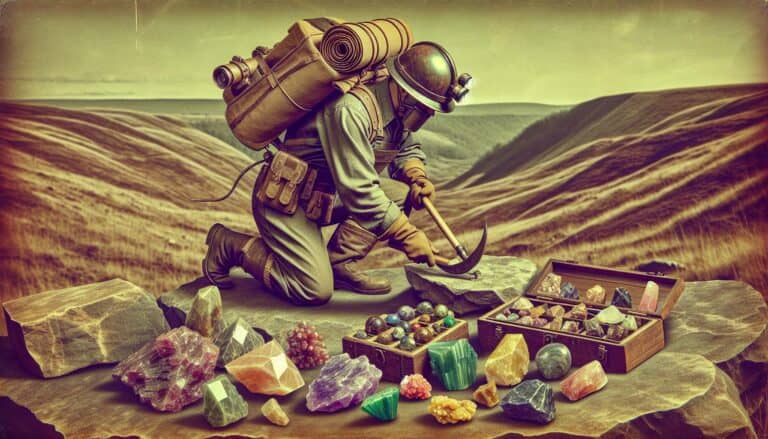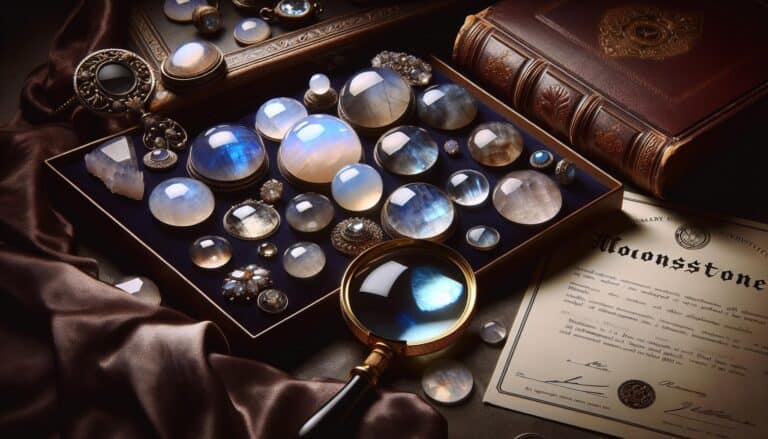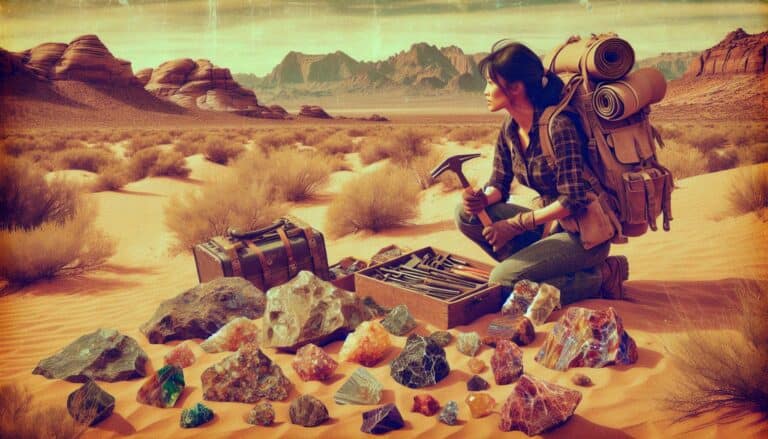Discovering the secrets of andalusite, a gemstone treasured for its unique pleochroism, is like unlocking a hidden treasure chest.
You’re about to learn how to identify this mineral with ease.
From its distinct colors to its characteristic inclusions, andalusite stands out in the gem world.
Whether you’re a budding geologist or a jewelry enthusiast, knowing what sets andalusite apart will deepen your appreciation for this earthy gem.
To identify andalusite, examine its elongated orthorhombic crystals, pleochroic colors, and characteristic cruciform inclusions. Perform a streak test for a white mark, check for non-magnetic properties, and test hardness (7.5 on the Mohs scale). Andalusite’s specific gravity is between 3.13 and 3.16.
How to Identify Andalusite Through Testing
Visual Inspection
To begin identifying andalusite, examine the crystal structure. Look for its typical elongated orthorhombic crystals. Andalusite often displays pleochroic qualities, showing different colors when viewed from various angles. Colors can range from yellow, green, brown, to reddish-brown. Inspect for any unique inclusions, which are often cruciform, cross-shaped inclusions characteristic of andalusite.
The Streak Test
Perform The Streak Test by rubbing the mineral across a white, unglazed porcelain tile. Andalusite typically leaves a white streak, regardless of the color of the specimen. This is a handy way to differentiate it from other minerals that may leave a colored streak.
Magnet Test
While andalusite is not magnetic, using a strong magnet can help identify magnetic inclusions within the stone. If the specimen reacts, it could indicate the presence of magnetite or other iron-rich minerals, not characteristic of pure andalusite.
Hardness Test
Andalusite ranks 7.5 on the Mohs scale of hardness. To test, try scratching the surface with a steel file or a quartz crystal. If it scratches the quartz or remains unscratched by the steel, it’s likely andalusite. This places the stone’s hardness above that of common glass.
Birefringence Test
This test involves analyzing the gem under polarized light to observe birefringence. Andalusite exhibits weak to moderate birefringence. When rotated between crossed polarizers, variations in light and dark will confirm this property.
Checking The Diaphaneity
Observe the stone’s diaphaneity or transparency. Generally, andalusite is transparent to translucent. Hold the specimen up to light to check how light passes through. This evaluation helps distinguish it from similar-looking opaque gems.
Single or Double Refraction
Determining refractive qualities is crucial for gem identification. Andalusite is anisotropic, showing double refraction. When viewing through a loupe, two slightly offset images might be seen due to this property.
Refractive Index Test
To get more precise, measure the refractive index using a refractometer. Andalusite has a refractive index ranging from 1.629 to 1.650. This measurement is a reliable indicator of the gem’s identity and can separate andalusite from other similar minerals.
Finding The Specific Gravity
Measure the specific gravity to distinguish andalusite from visually similar minerals. The specific gravity for andalusite is typically between 3.13 and 3.16. Achieve this through hydrostatic weighing or with the use of a heavy liquid series.
Identifying Andalusite in the Field
In the field, look for andalusite where metamorphic rocks are present. It often forms in regions of schist and gneiss. Knowledge of the host rock can be a strong indicator during identification.
Recognizing Potential Andalusite Rocks
Understanding the typical geological settings of andalusite is key. Look for substantial outcroppings of metamorphic rocks, specifically those that have undergone medium-grade metamorphism. Andalusite is often associated with other metamorphic minerals such as kyanite and sillimanite.
Physical Characteristics of Andalusite

When you’re on the hunt for andalusite, knowing its physical characteristics is crucial. Andalusites are typically characterized by their shape—the prismatic crystals often feature distinct cross-shaped patterns that can be a key indicator of their identity. Moreover, their color range can include a variety of hues, such as yellow, green, red, brown, and colors in between. These variations are due to impurities within the mineral which can give each specimen a unique appearance.
The hardness of andalusite falls between 6.5 and 7.5 on the Mohs scale, showing a significant resistance to scratching which is similar to that of quartz. This is a distinct feature that helps in differentiating andalusite from softer minerals within field settings. Additionally, the cleavage of andalusite is generally poor, indicating that it doesn’t split easily along well-defined planes which further aids in its identification.
The specific gravity of andalusite ranges from 3.13 to 3.16, providing a concrete measurement to distinguish it from look-alike minerals. This substantial density reflects its durable and high-quality nature suitable for various jewelry and industrial applications. Make sure you have accurate scales when attempting to measure specific gravity.
In addition to these characteristics, andalusite’s luster can vary from vitreous to subvitreous, meaning it can appear glass-like or slightly less shiny. This helps confirm the mineral when you’re sorting through potential samples. Keep in mind that lighting conditions can affect luster visibility, so it’s best to view your samples under consistent lighting.
Remembering these physical traits will equip you with the knowledge to identify andalusite with confidence. Always carry a field guide or reference materials to compare and confirm your findings as you explore.
How Are Andalusite Formed?
Andalusite takes shape under high-pressure and low-temperature conditions typically found in metamorphic rocks. These rocks form as a result of the metamorphism of clay-rich, sedimentary parent rocks called pelites. During regional metamorphism, the intense heat and pressure cause the structure of these pelites to transform, thus creating andalusite along with other metamorphic minerals.
The formation of andalusite is strongly linked to regional metamorphism, a geological process that alters the mineral composition of rocks over vast areas. This process is usually associated with the collision of tectonic plates, which exerts significant stress and heat on the encompassing rocks, fostering the growth of andalusite crystals.
Interestingly, the presence of andalusite is also indicative of the P-T conditions (pressure-temperature) the host rock was subjected to during its formation. The mineral kyanite forms under high pressure and lower temperature, while sillimanite forms at higher temperatures; andalusite represents an intermediate P-T range. This knowledge allows geologists to map out the metamorphic history of an area by analyzing the distribution of these index minerals.
When you’re in the field, recognizing these geological conditions can clue you in on where to find andalusite. Look for areas where mountain-building events have occurred, as the pressures from these orogenies make ideal conditions for andalusite formation. Keep an eye out for schist and gneiss, which commonly host andalusite, but remember that its occurrence might also signify a broader geological story tied to the region’s metamorphic past.
Preparation for Andalusite Hunting
Gathering the Right Tools
Before setting out to hunt for andalusite, it’s crucial to have the right tools on hand. Your success hinges on preparation. Start by assembling a geologist’s hammer, an essential for extracting samples. You’ll also need a hand lens or a jeweler’s loupe to scrutinize your finds for the distinct pleochroic properties of andalusite. Don’t forget to bring along safety goggles to protect your eyes from flying debris. A hard, durable field notebook and pencil will be your best friends for recording observations; whereas a GPS device or detailed topographic maps can guide you through unfamiliar terrain. Your kit should also include:
- A magnet for conducting a magnet test
- A streak plate to determine the streak color of the mineral
- Acid for a fizz test, which can help differentiate andalusite from carbonates
- A portable hardness testing kit for on-site hardness verification
Sturdy collecting bags or containers will keep your finds safe during transport. These tools will maximize your chances of correctly identifying andalusite specimens in the field.
Safety Considerations
Your safety is paramount when searching for andalusite. Always let someone know your plans and expected return time. Be mindful of the weather and dress appropriately; layers are key to combat sudden changes in temperature, especially in regions where andalusite is typically found. Durable hiking boots provide stability and traction on uneven terrains while protecting your feet. Bringing along a first aid kit prepped with essentials to address any minor injuries is a smart move.
Stay hydrated and energized by packing sufficient water and snacks. A whistle and flashlight may come in handy if you find yourself in an emergency situation. Most importantly, familiarize yourself with the local wildlife and understand the risks. If your hunt takes you to remote or wooded areas, consider bear spray or other deterrents in regions where dangerous animals are present.
Equipped with these insights, you’re all set to venture out into the field with confidence, on the lookout for those elusive, yet telltale signs of andalusite.
Handling and Care of Found Andalusite

Cleaning Andalusites
Once you’ve successfully identified and collected andalusite specimens, it’s essential to clean them properly to reveal their natural luster and impressive color variations. Begin by gently brushing off any loose dirt with a soft-bristled brush to avoid scratching the mineral’s surface. For more thorough cleaning, soak your andalusites in warm, soapy water for a few hours. This will help to loosen any stubborn grime. Afterwards, rinse them in clean water to remove any soap residue. If your andalusite has a significant build-up of material, consider using an ultrasonic cleaner, but always check for any existing cracks that may worsen during this process.
Avoid using harsh chemicals as they can easily damage the surface of the andalusite or alter its natural color. Once cleaned, pat the stones dry with a soft cloth. If you’re uncertain about the best cleaning method, seek advice from professional gemologists who can provide tips specific to your andalusite’s condition.
Storing Andalusites
Proper storage is paramount to maintain the condition of your andalusite specimens. To prevent scratches or chips, wrap each gemstone in a soft cloth or place them in a fabric-lined jewelry box. If you’re storing multiple stones together, ensure each one is individually wrapped to avoid contact, which could lead to abrasions.
For long-term storage, keep your andalusites in a cool, dry place to prevent any potential damage from humidity or temperature changes that can affect the integrity of the mineral. Avoid direct sunlight as it can cause some minerals to fade over time.
If your andalusite is set in jewelry, it’s essential to protect it from bumps and scrapes by storing it in a separate compartment within your jewelry box. Remember, even though andalusite is relatively hard and durable, it requires care and attention to keep it looking its best. Regular checks for any loose settings or damage can help preserve its beauty for years to come.
Conclusion: Confirming Andalusite are Real
Armed with the knowledge of andalusite’s distinctive features and the practical testing methods, you’re now ready to confirm your finds with confidence.
Remember, the unique crystal structure and pleochroic effects are your first clues. When you’re out in the field, keep your eyes peeled for those specific geological settings where andalusite loves to hide. Don’t forget the importance of proper preparation and safety while hunting for these gems. Once you’ve secured your specimens, handle them with care to preserve their natural beauty.
Happy hunting and enjoy the journey of discovering and identifying andalusite!







